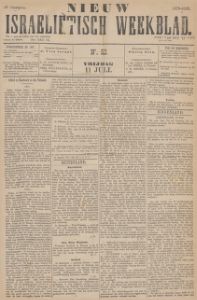About the day » Friday July 11, 1879Calender converter
Born on Friday July 11, 1879
- Adriana Martina Koenen, Monster († 1944)
- Adrianus Gerardus Martinus Schol, Twello (Voorst) († 1967)
- de Vries, Surhuisterveen, Achtkarspelen, Friesland, Nederland († 1879)
- Anna Cornelia Suijkerbuijk, Rucphen-St. Willebrord, Noord-Brabant, Nederland
- * Johanna Adriana van 't Hoff (van 't Hof), Nieuw-Beijerland, Zuid-Holland, NL († 1880)
- Anna Johanna van Beek, Ammerzoden, Gelderland, Nederland († 1951)
- Alida Margaretha Andriessen, Naarden, Noord-Holland, Nederland († 1935)
- Anna Gertrudis Norberta Schijvens, Tilburg († 1950)
- Anna Cornelia SUIJKERBUIJK, Rucphen, Nederland, Noord-Brabant, Nederland († 1965)
- Adrianus Laurentius Gabriels, Klundert († 1879)
Died on Friday July 11, 1879
- Arie Laagwater (35), Amsterdam
- ARIAANTJE SPRUIT (56), ALBLASSERDAM
- Bernardina Grobben (80), Dordrecht, Zuid-Holland, Nederland
- Antje Mathilda Dupuis (du Puis) (0), Rotterdam, Nederland
- Aagje Heeren (187) (73), Aalsmeer
- Alexander Cawsey #7008*05d (82)
- Anna Catharina Weijers (76), Nijmegen
- Cato Wikke (20), Velsen, Noord-Holland, Nederland
- Coenraad Lerk (67), Leeuwarden
- Arie Laagwater (35), Amsterdam
Source: Delpher (KB | national library) Newspapers from July 11, 1879 at Delpher
- Het nieuws van den dag : kleine courant
- De Tijd : godsdienstig-staatkundig dagblad
- Nieuw Israelietisch weekblad
- Suriname : koloniaal nieuws- en advertentieblad
- Algemeen Handelsblad
- Java-bode : nieuws, handels- en advertentieblad voor Nederlandsch-Indie
- Rotterdamsche courant
- Rotterdamsch nieuwsblad
- De standaard
- Leeuwarder courant
Born on July 11
- 1866 » Princess Irene of Hesse and by Rhine († 1953)
- 1875 » H. M. Brock, British painter and illustrator († 1960)
- 1880 » Friedrich Lahrs, German architect and academic († 1964)
- 1881 » Isabel Martin Lewis, American astronomer and author († 1966)
- 1882 » James Larkin White, American miner, explorer, and park ranger († 1946)
- 1886 » Boris Grigoriev, Russian painter and illustrator († 1939)
- 1888 » Carl Schmitt, German philosopher and jurist († 1985)
- 1892 » Thomas Mitchell, American actor, singer, and screenwriter († 1962)
- 1894 » Erna Mohr, German zoologist († 1968)
- 1895 » Dorothy Wilde, English author and poet († 1941)
Died on July 11
- 1806 » James Smith, Irish-American lawyer and politician (b. 1719)
- 1825 » Thomas P. Grosvenor, American soldier and politician (b. 1744)
- 1844 » Yevgeny Baratynsky, Russian philosopher and poet (b. 1800)
- 1897 » Patrick Jennings, Irish-Australian politician, 11th Premier of New South Wales (b. 1831)
- 1905 » Muhammad Abduh, Egyptian jurist and scholar (b. 1849)
- 1908 » Friedrich Traun, German sprinter and tennis player (b. 1876)
- 1909 » Simon Newcomb, Canadian-American astronomer and mathematician (b. 1835)
- 1929 » Billy Mosforth, English footballer and engraver (b. 1857)
- 1937 » George Gershwin, American pianist, songwriter, and composer (b. 1898)
- 1959 » Charlie Parker, English cricketer, coach, and umpire (b. 1882)
Names that were popular for boys in 1879
- Johannes
- Jan
- Hendrik
- Cornelis
- Willem
- Pieter
- Gerrit
- Jacob
- Petrus
- Jacobus
- Adrianus
- Dirk
- Arie
- Hendrikus
- Gerardus
- Wilhelmus
Names that were popular for girls in 1879
- Maria
- Johanna
- Anna
- Cornelia
- Elisabeth
- Adriana
- Catharina
- Hendrika
- Wilhelmina
- Grietje
- Aaltje
- Neeltje
- Jacoba
- Trijntje
- Antje
- Petronella
Source: Wikipedia Historical events 1879
- Koning Willem III (Huis van Oranje-Nassau) was from 1849 till 1890 sovereign of the Netherlands (also known as Koninkrijk der Nederlanden)
- In The Netherlands , there was from November 3, 1877 to August 20, 1879 the cabinet Kappeijne van de Coppello, with Mr. J. Kappeijne van de Coppello (liberaal) as prime minister.
- In The Netherlands , there was from August 20, 1879 to April 23, 1883 the cabinet Van Lijnden van Sandenburg, with Mr. C.Th. baron Van Lijnden van Sandenburg (conservatief-AR) as prime minister.
- The Netherlands had about 4.0 million citizens.
- February 8 » Sandford Fleming first proposes adoption of Universal Standard Time at a meeting of the Royal Canadian Institute.
- February 8 » The England cricket team led by Lord Harris is attacked in a riot during a match in Sydney.
- March 29 » Anglo-Zulu War: Battle of Kambula: British forces defeat 20,000 Zulus.
- April 5 » Chile declares war on Bolivia and Peru, starting the War of the Pacific.
- April 23 » Fire burns down the second main building and dome of the University of Notre Dame, which prompts the construction of the third, and current, Main Building with its golden dome.
- October 8 » War of the Pacific: The Chilean Navy defeats the Peruvian Navy in the Battle of Angamos.
Weather July 11, 1879
The temperature on July 11, 1879 was about 14.9 °C. The air pressure was 2 kgf/m2 and came mainly from the west-northwest. The airpressure was 76 cm mercury. The atmospheric humidity was 61%.

 July 10, 1879
July 10, 1879